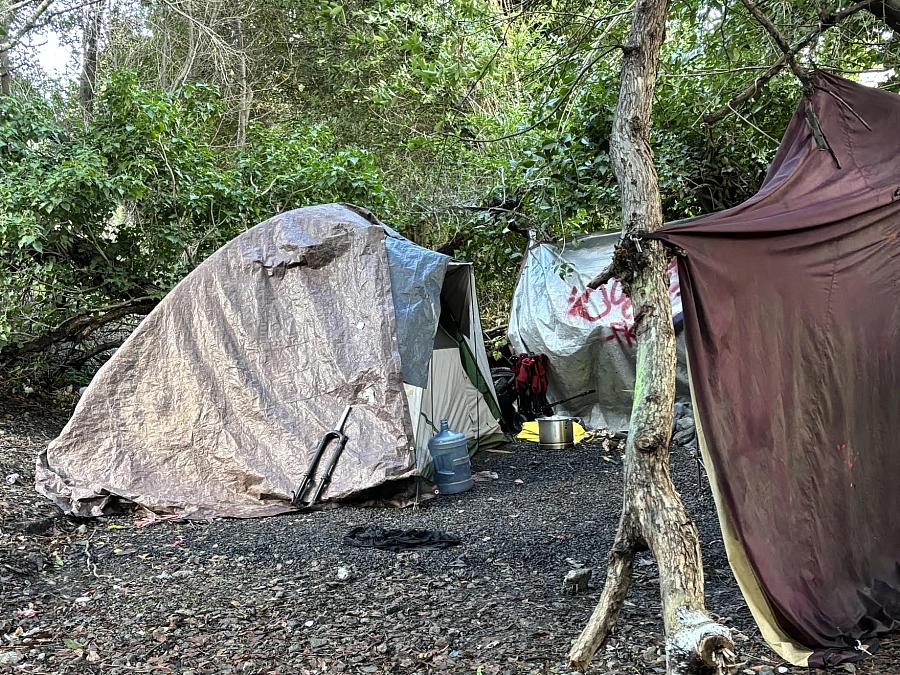Trauma-informed reporting proved crucial for untangling the role of PTSD in homelessness in Central California

A homeless encampment found during the 2024 point-in-time count in San Luis Obispo County.
(Photo via Amanda Wernik)
I remember a moment that profoundly shattered the privileged bubble I lived in. Strolling through downtown San Luis Obispo, I came across a homeless man sitting alone beside his tent. His face was streaked with tears. His body shook uncontrollably as he sobbed. That man’s pain left a lasting impression on me, igniting my journalistic drive to explore the untold stories of people like him.
When I began my data fellowship with the Center for Health Journalism years later, that memory resurfaced with newfound clarity. The most recent “point in time” data revealed that nearly half of the homeless people in San Luis Obispo County reported experiencing post-traumatic Stress Disorder (PTSD). I realized this was my chance to share the powerful stories of the individuals these numbers represent. This project became my quest to untangle the threads linking PTSD and homelessness, as I sought to understand whether trauma was a cause or a result in this intricate cycle.
Through the point-in-time survey data, it became evident that PTSD can play a huge role in the onset of homelessness. PTSD, which can develop after a traumatic event, causes the brain to struggle with the fight or flight response, leading to a constant perception of danger. This key feature of PTSD, which can make it hard to maintain stable commitments like jobs and relationships, often leads to a downward spiral.
What struck me most was the prevalence of childhood trauma among those with PTSD in the survey. These horrific experiences often set the stage for struggles later in life. One person I focused on, Chad Lamb, exemplified this cycle. With a childhood marked by abuse, Chad found it nearly impossible to navigate society's demands. This led to years of cycling between homelessness and incarceration. However, with compassionate support and targeted treatment from the nonprofit Transitions-Mental Health Association (TMHA) in San Luis Obispo, Chad's life took a hopeful turn.
Survey data also indicated that those with PTSD were more likely to face repeated bouts of homelessness. My reporting delves into a potential explanation for this trend: complex PTSD, which can stem from repeated traumatic experiences like physical assaults or theft while living on the streets. Conversations with a therapist revealed how homeless individuals with this type of PTSD can become trapped in a persistent cycle.
Finally, I delved into Transitions-Mental Health Association’s innovative housing-first approach, which shines as a beacon of hope in this story. Once people transition out of survival mode, it becomes easier to begin their journey toward stability.
Throughout my data fellowship reporting journey, I encountered several challenges that tested my patience, emotional resilience, and time management skills. One of the primary hurdles was obtaining the raw point-in-time data necessary for my project from the city of San Luis Obispo. This process was not straightforward and took several months of persistent communication and follow-ups.
For journalists facing difficulties obtaining necessary data and records, my advice is to remain persistent and hold people accountable to deadlines. When met with silence or delays, I would adjust my communication strategy. This meant shifting from emails to phone calls and, when necessary, showing up in person. This multipronged approach helped communicate my urgent need for the data. My persistent efforts paid off, and I successfully obtained the data.
Another huge challenge stemmed from the emotional weight of the stories I was covering. As a journalist, I aimed to authentically portray these stories without causing further harm or distress. To navigate this, I adopted a trauma-informed reporting approach. This practice prioritizes sensitivity towards trauma survivors by respecting boundaries, asking questions non-intrusively, and avoiding language that could retraumatize individuals. The goal is to ethically tell stories while preserving the dignity of those who have experienced trauma.
A crucial lesson I learned in trauma reporting was the importance of self-care. The graphic material I was covering eventually took a toll on my mental health, as stories of abuse and suffering echoed in my mind, keeping me awake at night. During the day, I felt numb and tired, simply going through the motions.
Looking back, I wish I had opened up more to others and taken the effects more seriously. I recommend other journalists who are reporting on traumatic material or undertaking large projects to prioritize their own mental health. Therapy, meditation, and confiding in trusted colleagues or friends can make a huge difference.
Through navigating and overcoming these challenges, I gained invaluable insights into the power of persistence, empathy and self-care in journalistic endeavors. This project has expanded my professional growth and deepened my connection to the stories I had the privilege of sharing.
A collaboration between KCBX Central Coast Public Radio and the USC Center for Health Journalism, this story is crucial for amplifying underrepresented voices in the region. When I saw one of the unhoused subjects I interviewed carrying a handheld radio, I realized public radio’s crucial role in democracy as a knowledge equalizer. As a local NPR station, KCBX’s role is to ensure that everyone in our community has access to high-quality, factual journalism.
I'm really looking forward to keeping these conversations going, sharing more insights, and emphasizing just how vital it is to truly connect with our communities when we tell their stories. By doing so, we not only inform but also empower and advocate for change where it’s needed most.

